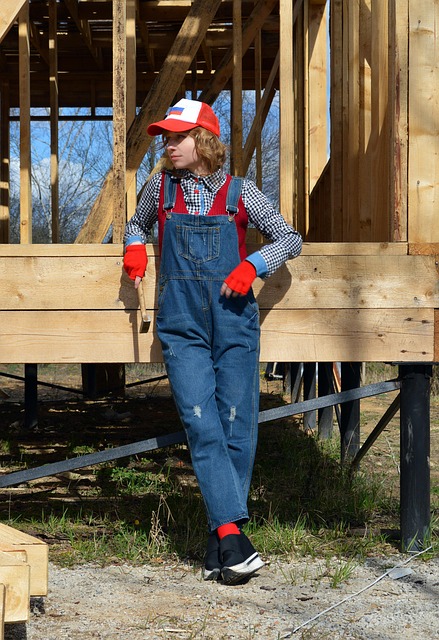Stem wall cracks, caused by environmental factors, structural stress, and construction flaws, are a common residential foundation repair issue. Assess cracks using measurements, structural stability tests, and visual inspections, documenting findings with photos. Repair methods vary based on crack severity; minor fractures can be sealed with hydraulic cement, while larger ones may require carbon fiber wrapping or replacement. Preparation includes safety gear, crack cleaning, and addressing root causes like soil movement. Repairs involve specialized tools, structural epoxy for deep cracks, and patches/mesh for smaller ones. Post-repair inspections ensure stability, and regular maintenance, including drainage control and waterproofing, prevents future stem wall cracks. Early detection through routine inspections is crucial to maintain residential foundation integrity.
Stem wall crack repair is a critical aspect of residential foundation maintenance. Understanding the causes, such as settling, shifting soil, or structural failures, is key to effective fixing. This comprehensive guide delves into the process, from assessing damage and choosing repair methods to safety measures and post-repair care. Learn how to navigate this intricate task with our step-by-step approach, ensuring your home’s foundation remains robust and secure through expert strategies for future protection.
Understanding Stem Wall Crack Causes

Stem wall cracks can be a common issue in residential foundation repair, often caused by various environmental factors and structural stress. These cracks typically appear as horizontal or vertical lines on the stem wall, which is the vertical portion of the foundation supporting the structure. One primary cause is ground movement, such as settlement or shifting due to changes in moisture content or soil conditions. Over time, these movements can exert pressure on the stem wall, leading to cracks.
Another significant factor is differential settling, where different parts of a building settle at varying rates due to differences in soil support and load distribution. This phenomenon can cause stem walls to crack, especially if there are existing weaknesses or inconsistencies in construction. Additionally, structural defects, improper foundation design, or poor-quality materials during initial construction may contribute to the development and propagation of these cracks over time.
Assessing the Extent of Damage

When addressing stem wall crack repair in residential foundation repair, assessing the extent of damage is a critical first step. Inspect the crack itself for its length, width, and depth, using a measuring tape and penlight for visibility. Note any signs of structural instability or shifting in the walls, floors, or doors, as these could indicate more severe underlying issues. Additionally, check for moisture intrusion or mold growth around the crack, as these are clear indicators of potential water damage and further complications.
During your assessment, consider the age and condition of the home. Older homes may have cracks due to normal settling, but recent cracks could point to foundation problems that require immediate attention. Documenting the findings with high-quality photos will not only aid in future reference but also help professional contractors understand the scope of work required for effective residential foundation repair.
Choosing the Right Repair Method

When it comes to repairing stem wall cracks, especially in residential foundation repair, selecting the appropriate method is key. The choice largely depends on the extent and type of damage. For small, hairline fractures, a simple injection of hydraulic cement or polymer-based compounds can effectively seal them, preventing further erosion. This method is quick, cost-efficient, and suitable for maintaining the structural integrity of your home.
For larger cracks that compromise the wall’s stability, a more comprehensive approach is necessary. This might involve carbon fiber wrapping to reinforce the area or even complete stem wall replacement if the damage is severe. Professionals in residential foundation repair should assess the crack’s width, depth, and any signs of leaning or shifting to determine the most effective long-term solution, ensuring the longevity of your home’s foundation.
Preparation and Safety Measures

Before starting any repair work, ensuring proper preparation and safety is paramount for both the homeowner and the contractors engaged in residential foundation repair. The first step involves assessing the extent of the crack and identifying the root cause, whether it’s due to settling, shifting soil, or structural issues. This evaluation determines the appropriate repair method. Safety measures include donning protective gear like gloves, safety glasses, and a mask to prevent skin irritation, eye strain, and inhalation of dust particles. Additionally, ensuring adequate ventilation in the work area is crucial, especially when using chemical compounds for crack filling. The preparation stage also entails clearing the crack area of any debris or loose material, creating a clean surface for efficient repair.
Step-by-Step Repair Process

Stem wall crack repair is a crucial aspect of residential foundation repair, addressing structural integrity and preventing further damage. The process typically involves several steps to ensure effective and lasting results. First, assess the extent of the crack using specialized tools and methods to determine its depth and width, which will guide the subsequent repair approach. Once evaluated, the crack is cleaned and prepared by removing any loose debris or material, ensuring a clean surface for bonding.
Next, appropriate repairs are executed based on the crack’s characteristics. This might include injecting structural epoxy into deeper cracks for reinforcement or applying a specialized patch or mesh over smaller, superficial cracks to enhance strength and prevent future weakening. After repair, the area is thoroughly inspected, and any necessary adjustments made to guarantee the stem wall’s structural soundness. These meticulous steps contribute to maintaining the overall stability of the residential foundation, mitigating potential risks associated with crack propagation.
Post-Repair Maintenance Tips

After successfully repairing a stem wall crack, proper maintenance is crucial for long-term stability and to prevent future issues with your residential foundation repair. One of the key aspects is regular inspection, ensuring that any new cracks or signs of movement are identified early on. This proactive approach allows for prompt action, which can save time and money in the long run.
To maintain the integrity of the repair, keep the area around the stem wall clean and clear of debris. Moisture control is also essential; ensure proper drainage to prevent water from pooling against the walls. Regular sealing and waterproofing measures will help safeguard against future damage, ensuring your residential foundation remains robust and secure.
Preventative Strategies for Future Protection

Stem wall crack repair is not just about addressing existing issues; it’s also crucial for preventing future damage, especially in residential foundation repair. Regular inspection is key to early detection of cracks, which can be attributed to various factors like settlement, shifting soil, and extreme weather conditions. Homeowners should familiarize themselves with the common signs of stem wall issues, such as uneven floors, doors that stick, or visible gaps around windows.
To safeguard against future cracks, implementing preventative strategies is essential. This includes proper drainage around the house to deter water from pooling near the foundation. Additionally, maintaining adequate clearance between vegetation and the foundation can prevent root intrusion that may lead to structural damage. Regularly testing and adjusting sump pumps and drainage systems ensures optimal performance during adverse weather events. Moreover, applying a quality waterproofing membrane on exterior walls and using crack-prevention products during construction or renovation can significantly enhance resistance against stem wall cracks.
